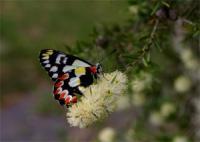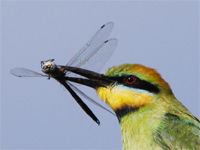Our male ‘red robins’ are iconic and distinctive, but the female and immature birds can present some challenges, especially in certain profiles.
Yesterday afternoon I came across all three local species – Flame Robin, Scarlet Robin and Red-capped Robin, foraging within metres of each other in a recently burnt area of the Muckleford Nature Conservation Reserve.
A brilliant male Flame Robin and several male Scarlet Robins eluded the camera and then a male Red-capped Robin perched dutifully in front of me. This species is more confiding in my experience. Females and/or immatures of all three species were then observed in the same general area. Hopefully the images and notes below are useful in helping readers separate what can be, in some cases, confounding ‘little brown birds’.

Red-capped Robin (adult male), Muckleford NCR, 9th April 2024
The next image below is a female Scarlet Robin with the peach-red breast largely obscured. The females of this species typically have grey (rather than brown) upperparts compared to the Red-capped or Flame Robin, and always a prominent white forehead spot

Scarlet Robin (female)
Red-capped and Flame Robins lack a white forehead spot in all plumages. The next two images are of a Red-capped Robin – the rusty cap is obvious, as are the pale, almost white underparts. There is quite a bit of yellow at the base of the bill and gape – possibly indicating a young bird. Some female and immature Red-capped Robins lack the rusty cap, while those with this feature can have a coloured wash on the breast similar to that of the female Scarlet Robin, but much paler.

Red-capped Robin

II
The final image is perhaps the trickiest. This bird is brown above and the cap is similar in colour to that of the Red-capped Robin pictured above. The lack of a white forehead spot and brown underparts confirm its identity, it’s a Flame Robin. Females and immatures of this species are, in my experience, not separable. An altitudinal migrant, the adult males we see locally are always in full regalia, suggesting that moulting into adult garb happens before the birds move onto the wintering grounds following breeding along the Great Divide. Both Scarlet and Red-capped Robins are locally resident, but largely inconspicuous over summer.

Flame Robin











Mary thanks Geoff, for the robins.
in the broad, for me the markings on the wings gives robins away. I might not be able to tell which one without the colour but I can be fairly certain it is a robin.
Hi Kate – spot on, the white wing bars are a shared feature amongst the Petroica robins, with subtle differences alone not really useful in distinguishing them. It is also worth looking out for Rose Robins at this time of year, especially in wetter gullies and drainage lines. Pink Robins are also a remote possibility but I’ve never seen one locally. Cheers, Geoff
So helpful!
Gorgeous photos and information generously shared once again. Thank you Geoff.
Great shots and information Geoff, thank you!
Could you give me some idea of where in Muckleford I should look for these beauties please?
Rgds Wendy
Hi Wendy – the area immediately north of Bells Lane Track is a good place to start, between Telecom Track and Red, White and Blue Track. At this time of year many of our bush birds, including robins, are quite mobile and often part of mixed species feeding flocks, A good strategy is to try and locate one of these flocks and you’ll often find robins are included. Cheers, Geoff
Thank you kindly Geoff, much appreciated!
Hello Geoff Park!
I thought it was high time I told you that I love your blog and have done for many years! It was your adorable Red-capped Robin which was the spur to my writing to you this morning.
All the best, Rosemary Thomason Sister of your neighbour Helen
>